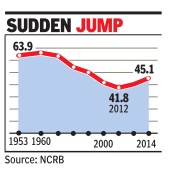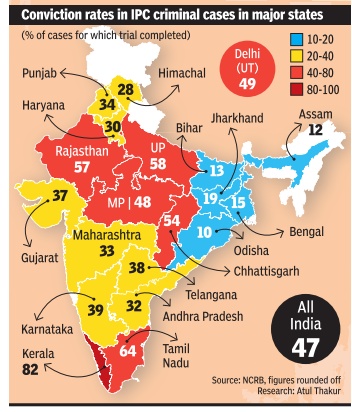Conviction rate: India
This is a collection of articles archived for the excellence of their content. |
Contents |
Conviction rate
1953, 1960, 2000, 2014

See graphic 'Conviction rate, India, 1953, 1960, 2000, 2014'
2006-15

See graphic 'Crime rate and conviction in %, 2006-15'
2012, 2014
The Times of India, Aug 09 2015
Deeptiman Tiwary
Kerala tops with over 77% convictions, Bihar worst with just 10%
In an indication that the quality of investiga tion by police and argumen of cases by prosecution may be improving, the latest data on disposal of criminal cases by courts show that convic tion rate is slowly but steadily improving. In fact, 2014 saw a jump o almost five percentage points in conviction rate over 2013 bringing last year's figures close to those in the 90s.
According to data on con viction rate for 2014, collated by National Crime Records Bureau (NCRB) and present ed by the government in Parliament, the percentage o cases in which the accused re ceived punishment stood at over 45%. In 2013, the same figure was 40.2% while in 2012 it stood at 38.5%.
In 2014, Kerala was the best performing state with over 77% convictions while Bihar was the worst with just 10%.
The trend is significant as since independence conviction rate in cognisable crime (offences which fall under Indian Penal Code) have been consistently falling. The oldest record in this respect is that of 1953, the year when NCRB began collating crime data. In that year, the percentage rate of conviction to total cases tried was almost 64%.In the next decade it improved to 65%. However, 70s onwards it has been consis tently declining, dropping to less than 40% in 2012.
Putting the matter in perspective, a senior home ministry official said, “Not only are investigating techniques improving thanks to greater use of technology such as DNA testing and other forensics, one big change that has come about is that it is no more easier to falsely impli cate people and get away with it. Police thus is more careful before chargesheeting someone.
The cases where several accused mentioned in the FIR do not figure in the chargesheet have increased. This is resulting in better conviction.One can only hope this trend will continue.“
The 2014 data show that among the larger states with better conviction rates, Kerala is the best. In 2014, it has recorded a conviction rate of 77.8%. Its nearest competitor, Tamil Nadu is almost 12 percentage points behind with a rate of 65.9%.
Even Uttar Pradesh, with its infamous lawlessness, does better than the national average clocking 53.2%. Bihar is the worst with 10% conviction rate followed by West Bengal where the figure is 11%. Maharashtra, which not too long ago had one of the worst conviction rates hovering at 6-7% has shown marked improvement clocking a rate of 19.3% in 2014. In 2013, the figure for Maharashtra was 13% while in 2012 it was just 9%.
Kerala stands out as an example to follow. With a poor conviction rate of 19.6% in 1992--when the national average stood at 46.4%, the state more than doubled its conviction rate in a decade with the 2002 figures reading 50.2%.
In 2012, it got over 65% cases securing conviction and in 2013 improved the same to over 68%.
2015

See graphic:
Conviction rates in IPC criminal cases in major states, presumably in 2015
2019
Bharti Jain, October 3, 2020: The Times of India
The all-India chargesheeting rate for crimes under the IPC that were investigated in 2019 was 67.2%, a slight dip from 68.1% in 2018, while the conviction rate improved marginally to 50.4% from 50% in 2018.
Chargesheeting rate, an indicator of disposal of crime cases by the police, is a calculation of such cases as a percentage of total cases disposed of by the police. Conviction rate, indicator of disposal of crime cases by courts, is defined as such cases as a percentage of those in which trial was completed by courts. Kerala (85.1%) topped on conviction rate for all IPC crimes in 2019, followed by Tamil Nadu (63.2%).